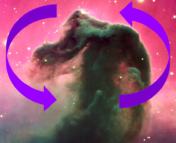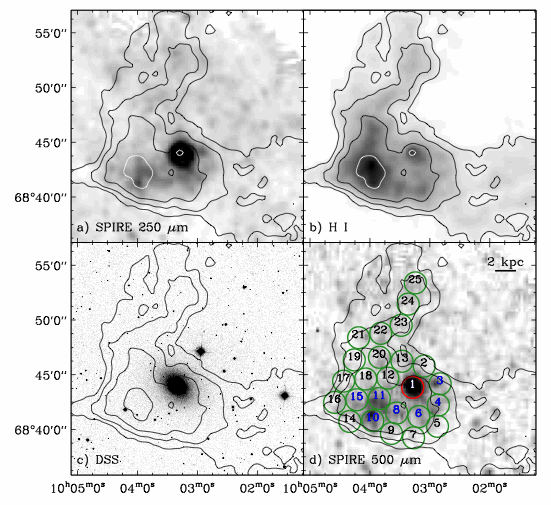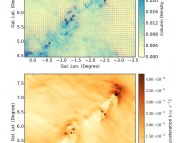Title: Magnetic Fields in the Horsehead Nebula
Authors: Jihye Hwang, Kate Pattle, Harriet Parsons, Mallory Go, Jongsoo Kim
First Author’s Institution: Korea Astronomy and Space Science Institute (KASI), Daejeon, Republic of Korea
Status: Accepted in the Astronomical Journal [open access]
Molecular clouds are star factories. They are dense regions of the interstellar medium (ISM) primarily composed of molecular hydrogen along with other molecules and dust. When the clouds become dense enough (astrophysicists call it reaching the “Jeans mass“), gravity takes the stage, pulling everything together into clumps. As they contract, the temperature rises, things heat up, and boom! Nuclear fusion kicks in at the core of these gas balls, and voila, a star is born!
How do these clouds get packed enough in the first place? Imagine it’s like a space traffic jam: molecular clouds crash into each other to create these dense regions, and even entire galaxies can have cosmic fender-benders. Other times, supernova explosions or radiation pressure from nearby stars (remember this part, it’s necessary!) can nudge the gas around, creating these high-density spots.
However, star formation faces some challenges, too. When star formation slows down, it’s because of a process called feedback. In feedback, stars produce winds that push the gas away, reducing ISM density. They also produce ionising radiation that heats the molecular clouds, causing them to swell instead of collapsing to form stars. Magnetic fields within molecular clouds can also prevent cloud collapse from either gravitational forces or radiation pressure (keep this in mind as well!). We’re still figuring out how much feedback influences star formation and on what scales it acts.
Because there are many things we still need to learn about how stars are born and the feedback process, astronomers have been turning to the Orion Molecular Cloud Complex to explore these questions. It’s one of the closest and biggest stellar nurseries around. The cloud complex has spots like the Orion Molecular Cloud 1, the Orion Bar, and the Horsehead, where astronomers have attempted to study multiple factors involved in star formation and feedback.
In this article, the authors focus on the influence of the magnetic field on the molecular cloud in the Horsehead. The goal is to determine whether this magnetic field plays a role in preventing the collapse of the Horsehead and the subsequent formation of stars.
The Anatomy of the Horsehead
To the southwest of the Horsehead (see Figure 1) lies an O-type star called σ Orionis (σ Ori). This star boasts a mass about 18 times that of the Sun and has a scorching surface temperature of around 35,000 Kelvin. From Wien’s displacement law, we know that this star emits ultraviolet (UV) photons. These UV photons have sufficient energy to ionise the neutral hydrogen gas within the interstellar medium, forming the HII region (dashed area in Figure 1). Past the HII region, the interaction between UV radiation and molecular clouds (solid black area in Figure 1) can lead to the collapse of gas and the formation of new stars.

The intense UV radiation, however, doesn’t penetrate deep into the molecular cloud due to the absorption and scattering by dust grains. Instead, it creates a boundary layer at the surface of the cloud where the UV radiation is strong enough to dissociate molecules but not so intense as to ionise them completely. This boundary layer is called the Photo Dissociation Region (PDR). The ‘head’ of the Horsehead is a PDR.

How do we take the MRI?

The tiny bits of dust in the molecular cloud are not round; they’re more stretched out. When light bumps into them, it makes them spin like a spinning top around a magnetic field. While they spin, they lose energy and line up with the magnetic field such that their short axis is parallel to the magnetic field. When these aligned dust particles then emit light, the light wave oscillates in just one direction (denoted by vector E in Figure 3), which happens to be perpendicular to the magnetic field (marked by vector B in Figure 3) in the molecular cloud. This means the light is polarised. Hence, the plane-of-sky magnetic field can be obtained by rotating the polarisation angle of observed light by 90 degrees.
So, what’s the diagnosis?
The Horsehead’s plane-of-sky magnetic field (black dashes in Figure 4 (left)) reflects that the ‘neck region’ inherited the magnetic strength and orientation from its parent molecular cloud (orange dashes in Figure 4) prior to undergoing a shock.
In contrast, the magnetic field in the Horsehead’s head region undergoes compression and reorganisation due to its interaction with the HII region. Despite the magnetic field protruding like a unicorn’s horn in the plane-of-sky view, the magnetic field aligns parallel to the shell-like surface of the PDR in 3D, which has folded back on itself along the line of sight.

Does the magnetic field prevent the Horsehead from collapsing? To do so, it must be stronger than the molecular cloud’s self-gravity, as well as its turbulence. To compare the magnetic field strength with self-gravity, they used the ratio of the mass of gas to the strength of the magnetic field, called the mass-to-flux ratio. To compare the magnetic strength with turbulence, they used the Alfvén Mach number. In both cases, the magnetic field strength proved to be stronger, supporting the Horsehead from collapsing and preventing star formation. Hence, this article highlights the crucial role magnetic fields play in shaping stellar nurseries, paving the way for further investigations into the intricate interplay between magnetic forces and star formation.
Astrobite edited by Caroline von Raesfeld and Katherine Lee.
Featured image credit: ESA/Euclid/Euclid Consortium/NASA, image processing by J.-C. Cuillandre (CEA Paris-Saclay), G. Anselmi.




